Christ Church Cathedral & St. Patrick’s Cathedral in Dublin, Ireland – How Barley Barons Saved Them
categories: europe travelHard to believe now, visiting two of Dublin’s most popular tourist attractions, neither of her famous Cathedrals nearly made it. Had it not been for two of the city’s great barley barons, Benjamin Guinness of the famous brewery clan, and Henry Roe of the Thomas Street distillery, we might be visiting ruins today. Their 19th-century contributions saved each church for their parishioners and our current enjoyment.
Table of contents: ()

While Christ Church had formal precedence, as the mother and senior cathedral of the diocese, over St. Patrick’s Cathedral, various monarchs through time took drastic actions against one cathedral in favor of the other. Christ Church is the elder of the two medieval cathedrals and it is originally situated within the walled medieval city. This made her susceptible to the laws and taxes of the city, from which St. Patrick’s was exempt.
Christ Church Cathedral
Dublin’s Christ Church Cathedral is the oldest structure in the city at nearly 1000 years. Its architecture is a mixture of medieval, gothic and Victorian. Through multiple renovations, stained-glass windows dominate. Attention to detail is noted in specific floor tiles of the cathedral nave. Look for the foxy friars. There’s space to explore above, as you climb the staircase to the belfry to ring the famous bells, and below, as you descend to the largest medieval crypt in Ireland. The crypt contains additional treasures of Christ Church, including priceless silver and, historically priceless, Ireland’s first copy of the Magna Carta.
At the west end of the cathedral is a fully integrated stone bridge, a Dublin landmark, leading to the former synod hall. It had been built on the site of St Michael’s and was demolished by architect Street during his restoration of the cathedral. This hall, which incorporates the old St Michael’s tower, is now home to the “Dublinia” exhibition about medieval Dublin.
The Very Reverend Dermot Dunne, Dean of Christ Church Cathedral believes firmly “the mission of any cathedral is to reflect through its beauty the transcendence of God … we welcome everyone as a pilgrim and it is our hope that as the pilgrim leaves, he or she will have been touched in some way by the love of God which shines in the beauty of this place.”
Christ Church Cathedral, formally the Cathedral of the Holy Trinity, only became part of the Church of Ireland following the English Reformation. The Roman Catholic Archbishop of Dublin has used St. Mary’s on Marlborough Street as the “acting Cathedral” or ProCathedral for the past 200 years.
Christ Church History
According to Tommy Graham, Editor of Ireland’s HISTORY magazine and the fastest walking and fastest talking guide you’ll find in Dublin, Ireland was labeled “Hibernia” by the Romans, meaning “land of winter.” Ireland was never conquered by the Romans, who, “having visited once, took one look at the weather, and assuming it was always this bad, left forever.”
A church is thought to have stood at this Christ Church site since 800AD. Christ Church Cathedral, a wooden building at that stage, was founded in 1030, by Hiberno-Norse (old Irish for mixed Gaelic and Norse ancestry) King Sitric Silkenbeard after a pilgrimage to Rome. He was the Viking King of Dublin. By this time, the Vikings had become Christian.
Purported to have four old Celtic Christian churches at this time in Dublin, only Christ Church and St. Martin of Tours lay within the walls of the Viking city. Christ Church, with its original architectural context, existed at the center of a medieval street pattern, a maze of small buildings and streets.
Anglo-Normans
John Cumin, the first Anglo-Norman archbishop, is thought responsible for directing the replacement of the existing Hiberno-Norse cathedral with the Romanesque and later Gothic cathedral. Parts survive today.
The cathedral was rebuilt in stone in the 1170s by an Anglo-Norman feudal knight called Richard de Clare, the Earl of Pembroke from southern Wales. He’s better known by his nickname, “Strongbow.”
Strongbow proved himself a statesman who had “thrown in his lot” with the Irish. He learned the language and took an Irish wife. His success depended on theirs, he helped Ireland benefit from Norman rule after diplomatically convincing most of the chieftains of Leinster. He died from sepsis from a foot infection.
In the 1180s, the second Earl of Strongbow, Dermott McMurrough and other Norman magnates helped to fund the rebuilding of Christ Church. This included the construction of a choir, choir aisles, and transepts, the crypt and chapels to St. Edmund and St. Mary and St. Lô. McMurrough deposed the King of Lancaster and, in a sign of peace, promised the hand of his daughter, Aoife, (sounds like “Eva”), in marriage to Strongbow.
St Laurence O’Toole
Originally, the cathedral was staffed by secular clergy. The second Bishop of Dublin introduced the Benedictines. In 1163, Christ Church was converted to reformed Augustinian rule by the second Archbishop of Dublin, later saint, Laurence O’Toole. While he tended his flock, removed abusive priests from office, opened the first Dublin orphanage and fed the hungry, up to 30 a night, he was involved in politics. He negotiated terms with Strongbow following the capture of the city in 1170.
Laurence O’Toole died in France but his heart was transported back to Christ Church and kept until stolen in 2012. It was missing for 6 years but was returned to the Church by the burglars in 2018 after they suffered several family tragedies.
A chapel to St Laurence O’Toole, now the patron saint of Dublin, was added in the 13th century and much of the surviving nave was built in the 1230s. Its design was inspired by the architecture of the English western school of Gothic, and, according to the Christ Church guide, its wrought Somersetshire oolite stones were sculpted and laid by craftsmen from the same area.
In the 1350s a major extension was undertaken by John de St Paul, Archbishop of Dublin 1349-62. By 1358, the nave of the cathedral was partly in use for secular purposes and a “long quire” was added, extending the old choir area by about 30 feet. De St Paul also installed an organ. His works were destroyed by the major rebuilding project in the 1870s.
Crypt
The Christ Church underground held its own commerce. During the 16th and 17th centuries, Christ Church’s crypt was used as a market, a meeting place, and at one stage even a pub. It currently holds Ireland’s copy of the Magna Carta and several historic displays and treasures.
The tomb of Strongbow was used as the venue for legal agreements from the 16th to the 18th centuries. It was meant to bind borrowers to their debts and enforce the bonds of society.
Reformation
The Roman Catholic Church lost members following Martin Luther’s defection. On October 31, 1517, Martin Luther, angry with Pope Leo X’s new round of indulgences to help build St. Peter’s Basilica, nailed a sheet of paper with his 95 Theses on the University of Wittenberg’s chapel door.
Perhaps inspired by this, in 1534, King Henry VIII broke from Rome over issues of divorcing his first wife, Catherine of Aragon. He established a reformed Church of England, which, in 1871, became the Church of Ireland.
In 1539, the king converted the priory to a cathedral with a dean and chapter and worked to ensure Christ Church adhered to his new church structure. He officially dissolved the Augustinian priory in 1541. In 1547, his son and immediate successor, Edward VI, provided funds for an increase in cathedral staffing and annual royal funding for the choir school.
In 1562, the vaulting of the nave roof collapsed, smashing Strongbow’s tomb (now replaced. the current tomb is a contemporary replacement from Drogheda) and emergency repairs left the north nave wall leaning out 18 inches further than the south. You can see it if you stand at the altar and look back. Those “temporary” repairs lasted until the 1870s when the Roe family stepped in to pay for repairs rather than allow their beloved family church to fall into ruin, following the example of the Guinness family 10 years earlier just 5 minutes away at St. Patrick’s.
King Edward VI later formally suppressed St Patrick’s Cathedral. In 1547, its treasures were transferred to Christ Church, Queen Mary I, in 1558, had these items returned to Thomas Leverous, Dean of St. Patrick’s. Queen Mary, and Later King James I, later increased Christ Church’s endowment.
The cathedral system of the Church of Ireland collapsed during the Cromwell period and Christ Church was provided a new constitution in 1660, modified since 1870 by the Church of Ireland’s general synod.
In 1689, Catholic ex-King James II invaded Ireland and while there attended mass at Christ Church after and it was briefly returned to Catholicism. King William III who had replaced James in the Glorious Revolution of 1688 recaptured Ireland and returned the church to the protestant faith. He attended services here in 1690.
The Roe Family
While the John Jameson family is now the most famous for their whiskey, in 1832, George Roe inherited two distilleries, from cousins Richard Roe and Nicolas Roe, and expanded them. He founded the Thomas Street Distillery, the largest in Dublin, perhaps the world. At its peak, it was double the size of the Jameson factory on Bow Street. George and his sons George and Henry produced more than 2 million gallons of Irish whiskey annually by 1862. This large and prosperous business put the Roe family in a position of wealth and great influence.
At the same time the Church of Ireland was established independent of the Church of England, in 1871, she was disestablished as the state church. The financial abandonment of the cathedral by the state left lay people responsible for the building’s maintenance and governance.
George and Henry were approached about contributing the funds for the restoration of Christ Church Cathedral. By 1878, the family had donated £250,000, equivalent to $35 million today. They were subsequently knighted for their efforts.
Henry Roe worked closely with architect George Edmund Street from 1871-1878 and encouraged the Victorian architecture we see today. Street, himself, commissioned the stained-glass window in the cathedral baptistry of St. Laurence O’Toole, in memory of his wife. George Roe commissioned the Jesse tree stained glass window on the north wall.
The great 14th-century choir was demolished and a new eastern end was built over the original crypt. Informed tour guides are able to share additional changes. “The flying buttresses were added as a decorative feature. A new chapter house was built. The tower was rebuilt. The south nave arcade was rebuilt. The north porch was removed. The baptistry was built in its place.” Street built the adjacent Synod Hall, taking in the last remnant of St. Michael and All Angels’ Church, including the bell tower. The synod house is linked to the cathedral by Street’s iconic covered footbridge. This now holds DUBLINIA, the Viking tourist attraction.
The Thomas Street Distillery, facing financial difficulties due to Scottish competition, American Prohibition and the Anglo-Irish trade wars, closed in 1926. It has recently seen some resurgence (watch for it and purchase their whiskey!)
For most of their common history, both Christ Church and St Patrick’s held the status of a cathedral for the Dublin diocese. This was a rare arrangement in the Catholic Church yet only ended following the move to disestablish the Church of Ireland.
St. Patrick’s Cathedral
In 1191, St. Patrick’s Cathedral was built, outside the city walls, and named in honor of Ireland’s patron saint. St Patrick who, like St. Laurence O’Toole, spent part of his life in captivity. At 16, he was captured by pirates and spent 6 years as a shepherd. He escaped, returned to England, then was called to preach and returned to Ireland to convert the pagans to Christianity.
This cathedral, built from 1220-1259, is positioned on the site of an ancient well, thought to have been used by Patrick himself. The building replaced an earlier, also probably wooden, church.
The clergy of the church is uncommon. Archbishop John Comyn, an English non-priest was elected by the clergy in 1181 to Archbishop of Dublin following the death of Laurence O’Toole. Comyn elevated Saint Patrick’s to Cathedral status. This was unparalleled in the Roman Catholic Church and possibly only allowed because of the internal issue over the great Schism of 1054.
The credit for St Patrick’s construction goes to Archbishop Luke, Archbishop from 1219-1260. He was actually blind by the time the work was complete, so he never saw the full fruits of his efforts. Luke built a Gothic cathedral in a cruciform shape; with the main body of the church (known as the Nave) resembling the long part of a cross, the top of the cross known as the Choir, with the arms of the cross known as the Transepts. The tour guide said the design for Saint Patrick’s was based on Old Sarum Cathedral, near Salisbury in England.
After the English Reformation, Saint Patrick’s became an Anglican Cathedral. Modifications were made to its interior to suit Anglican standards. Many statues were removed. Decorations were stripped from the ceilings. Like Christ Church Cathedral, St Patrick’s suffered further during the reign of Edward VI. The Cathedral was demoted to the status of a parish church and was used as a courthouse and, for a short period, as a university. Queen Mary restored it to cathedral status in 1555. She allocated funds for repair and restoration.
At this time, there are three statues of St. Patrick within the church. One statue, on the wall, was piecemealed together from three separate forms. Another is kept under glass across from the first. The third is a statue near the entrance. In the back of the church, you see the 39 stained glass windows that represent St. Patrick’s life.
The Guinness family
Sir Arthur Guinness, along with his wife Olivia Whitmore Guinness, opened the Guinness Storehouse in 1759. Their brewing process takes barley and hops and clean water and turns it into a dark beer enjoyed billions of times a year. They were great philanthropists who helped form Dublin as we meet her today.
His grandson, Benjamin Lee Guinness (3rd son of Arthur 2 and Anne Lee), continuing the family legacy, was part of St. Patrick’s congregation and volunteered all funds needed for the restoration with one caveat. As an amateur architect, he insisted he be given free rein at the renovations. Under fear of destruction and loss of priceless artifacts, the cathedral’s dean, or head of the church, Henry Pakenham acquiesced. The renovations were completed under the watchful eye of Pakenham’s successor, John West.
In 1860, Benjamin spent approximately 150,000 pounds (appx 21M euro today). For his endeavors, he was made baronet, with title passing to his son, Benjamin, and Benjamin’s son thereafter.
It was Benjamin’s daughter Ann that married the Dean of the Cathedral. You can find her visage on a stained-glass window to the right of the altar behind the main choir. Under “her” window is the biblical quote, “I was thirsty and Ye gave me drink.” You can’t say the Guinness family didn’t have a sense of humor.
For the next five years, the Cathedral was closed for restoration. Guinness added a new ceiling to the nave and raised the floor to match the choir level. He removed all the screens between the nave, transepts, and choir.
When St Patrick’s reopened, the church appearance was highly celebrated. The Guinness family continues to contribute to its maintenance.
Benjamin Guinness diversified his financial holdings, specifically toward the Irish rail system, thus saving his fortune from the market changes that caused the Thomas Street distillery to close in the 1920s.
Tied through history, the Guinness family eventually incorporated the St. Patrick’s Tower from the original Thomas Street Distillery. This Tower, a 150 ft high brick-built windmill, is believed to be one of the oldest extant smock windmills amongst European windmills. It’s nearly as recognizable in Dublin as the Guinness St. James Gate.
Thanks to these two families, we have the ability to visit these awe-inspiring architectural marvels. These two barley barons saved the grandest cathedrals in Dublin. The Roe family lost their business due to economic events they couldn’t control while the Guinness family learned to maneuver through those events to become an even stronger company today. Overall, the public are the winners. The gratitude owed them, to allow us to see these cathedrals thanks to the philanthropy of the Roe and Guinness families, cannot be overstated. Funding for ongoing renovations comes from our admission fees to the cathedrals. Donate more if you can, every church needs a new roof before you realize it – save these cathedrals for the next generation.
Contact:
Christ Church Cathedral
ChristChurch Place
Dublin 8
00 353 1 677 8099
St Patrick’s Cathedral
St Patrick’s Close, Wood Quay, Dublin 8, Ireland
+353 1 453 9472
Resources:
Ireland Under The Normans 1169-1216 -, Volume 1
By Goddard Henry Orpen
Tour Guides from each Cathedral
[amazon_link asins=’B008ZIFNFG’ template=’ProductAd’ store=’chrischrissho-20′ marketplace=’US’ link_id=’ 603d5d03-08bc-40cd-a2dd-3e858eb1b7d9′

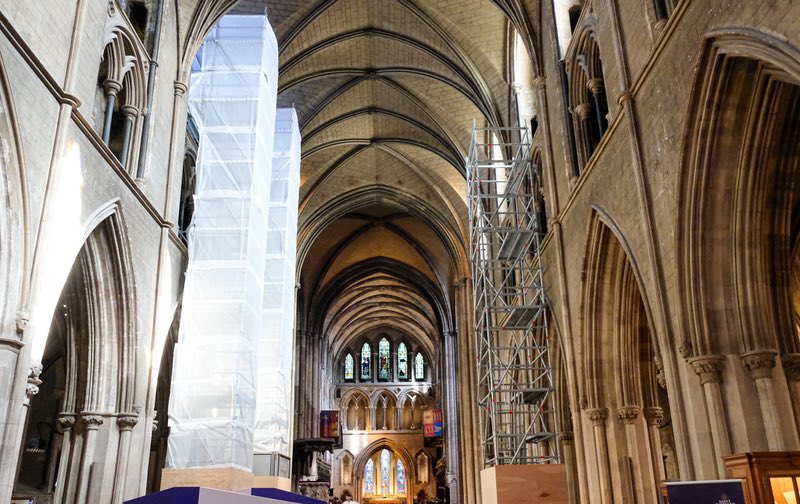

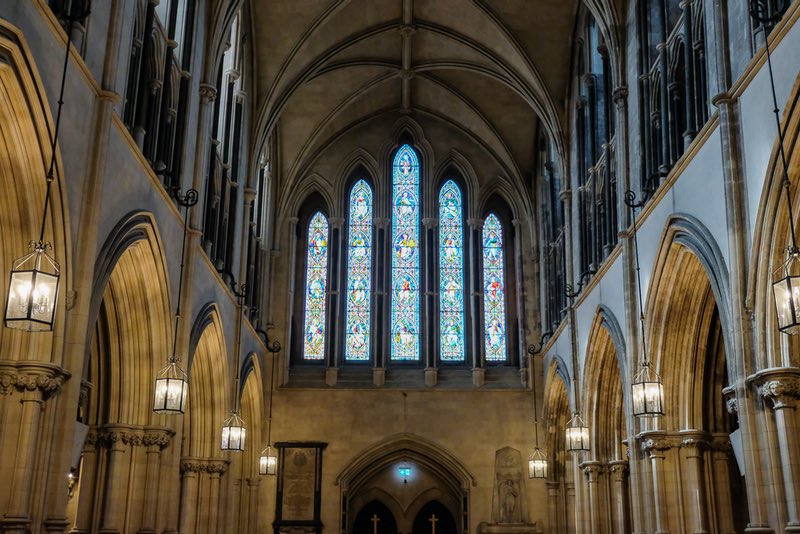
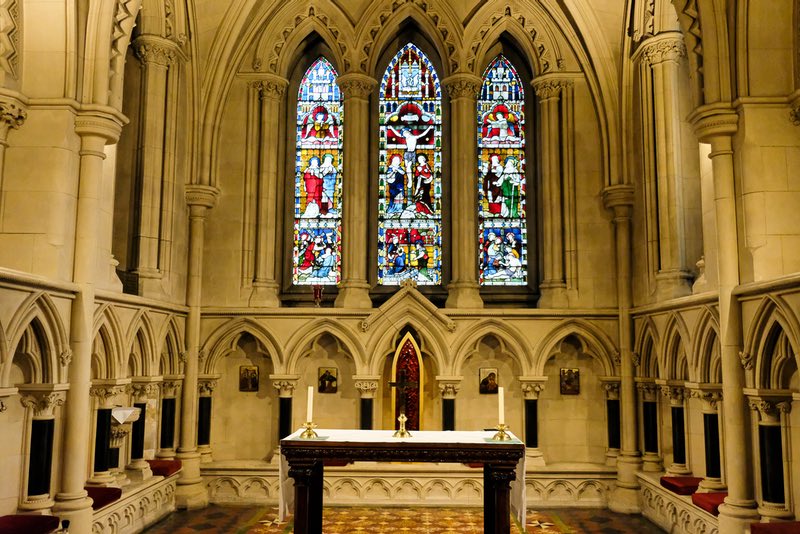
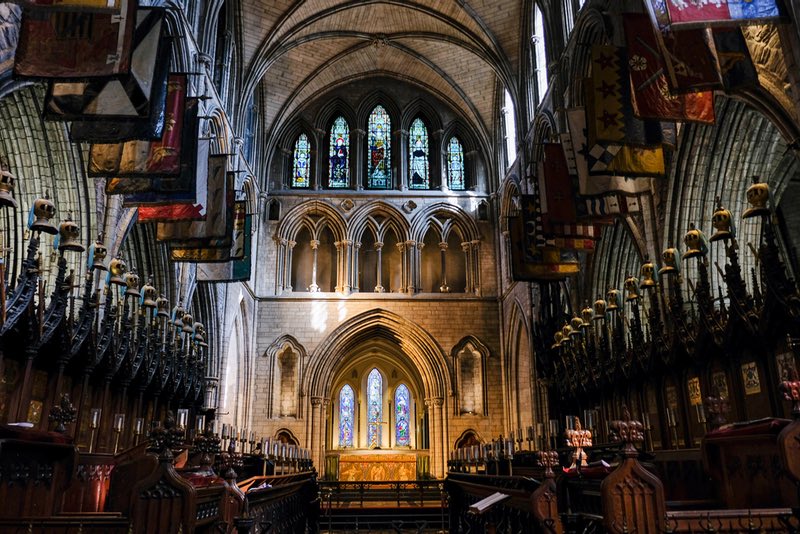
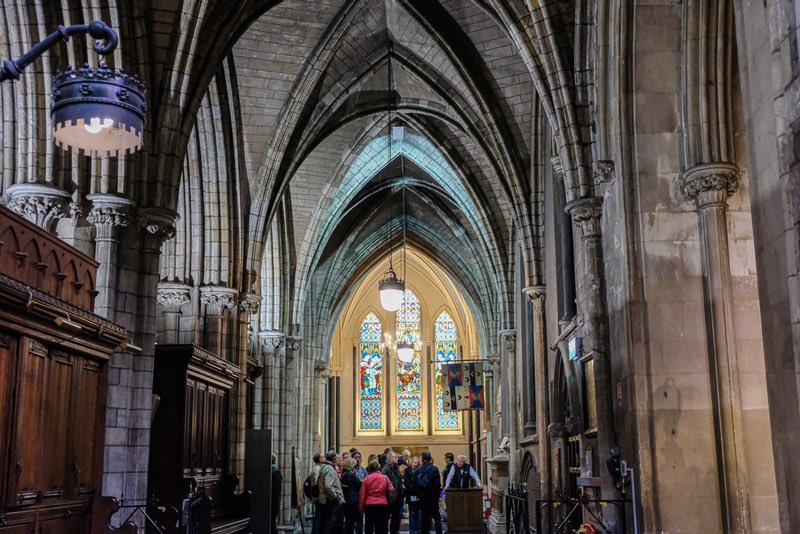
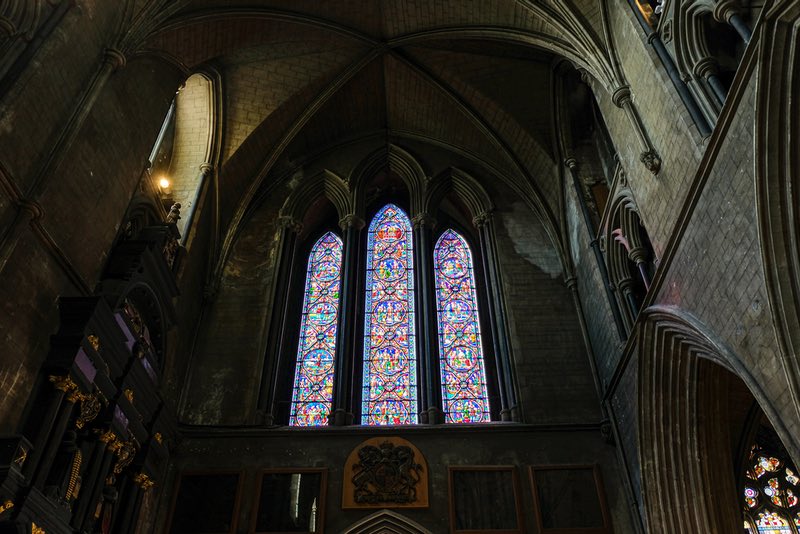
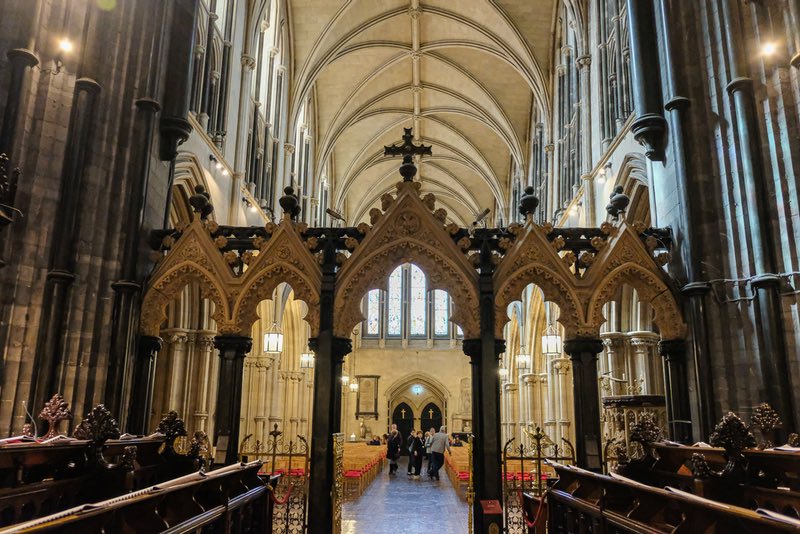
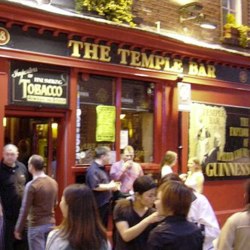 Travel to Dublin, Ireland – Episode 306
Travel to Dublin, Ireland – Episode 306 Store Fronts in Ireland – Photos
Store Fronts in Ireland – Photos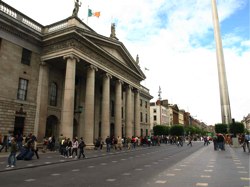 Travel to Ireland – Episode 145
Travel to Ireland – Episode 145 Photo Walking Tours of Dublin with Dawn2Dusk Tours
Photo Walking Tours of Dublin with Dawn2Dusk Tours


Deacon John Michel, Ed.D.
Says:April 27th, 2023 at 5:09 pm
I see that you have visited all 51 of the United States. While visiting Texas, I hope you visited the beautiful city of San Antonio, founded by the Spanish explorers in 1718.
Chris Christensen
Says:April 27th, 2023 at 9:33 pm
Last I checked there were only 50, but no, I have not made it to San Antonio yet.